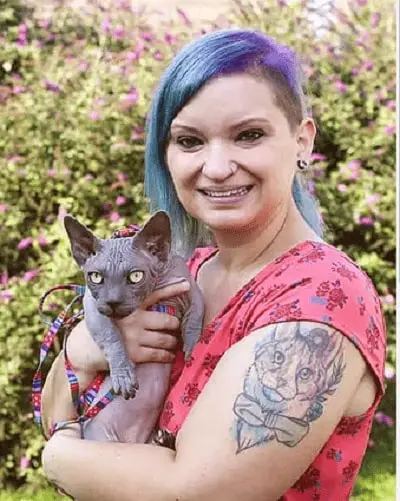Day in the life of
Zookeeper – Stephanie Mantilla
My name is Stephanie Mantilla. I was a zookeeper for over 12 years and senior carnivore keeper for the last 3 of those working with cheetahs, lions, tigers, and many other carnivores in my department. I’ve also worked with many rescued wild cats from the pet trade and entertainment industry. Part of this job included animal training. Now I am a full-time animal trainer for domestic animals instead of exotics.
What does a day in the life of a carnivore zookeeper look like?
Your day starts out early, oftentimes at 6 AM. This is because there’s a lot of work to be done to get the animals out on their exhibits before the zoo opens at 9 AM. Your first step will be to have a quick team meeting to schedule out the day and grab your radio. There are often keeper chats, donor tours, and special events that zookeepers will have to speak at or tour people around. The rest of the day is spent taking care of the animals.
The first thing a keeper does when they get to their assigned section is to do a walkaround to get a visual of each and every animal. This is to make sure all of the animals are doing alright and didn’t come down with an issue overnight while no keepers were on ground. After that, it’s time to give the animals their breakfast. Some animals will be on medicine so that will need to be portioned out and often hid in the food. An animal may be on meds for old-age related issues like arthritis or they could’ve had an injury they’re getting treated for.
The breakfast feeding is the perfect time to get some training in. Zookeepers use positive reinforcement-based animal training. Most of the behaviors that are trained are to get the animals to participate in their own daily care. This could be getting the animal to come inside when called, to allow an injection voluntarily, or open their mouth on cue to check their teeth.
After the morning feeding is done, it’s time to clean and prepare all the exhibits. Zookeepers will lock the animals inside while they go out onto the exhibit to pick up waste, check the integrity of the enclosure, and set up enrichment items for the animal to play with. Once the exhibit is set, the keeper will remove all the tools they brought out and lock up the exhibit. They’ll then shift the animal onto the exhibit and lock the animal out of their building dens. The animals receiving medicine may need to kept inside until the on-staff vets can come around and check on them. The keeper will have to get all the animals’ exhibits cleaned and the animals locked out onto them before the zoo opens around 9 AM. This is so the zoo guests will have animals to look at instead of watching zookeepers clean.
After 9 AM, it’s time to clean all of the indoor holding dens. For carnivores, this includes scooping up all waste, putting out hay beds if it’s cold, and setting up fun heavy-duty animal-safe toys for the animals to play with in the evening. Cleaning can take the rest of the morning until noon.
After a lunch break, it’ll be time to prepare the diets for the next day. This includes weighing out and chopping all the food. Depending on the species, some of the diets are complex with lots of variety. Each animal has a diet that was made and approved by a vet and nutritionist. All diets will be put into labeled containers and set in the fridge for the next day.
After diets, there are usually keeper chats and training demonstrations given at the front of the exhibits. This is done so the zoo guests can watch the animals getting trained and learn about them. Training also brings the animals up close to the front of the exhibit for a better view.
The remaining hour or so is spent writing keeper logs on all the animals, including how much each animal ate, what enrichment they received, training session logs, medical issues, and medicine compliance.
There is usually one or more keepers in each department who are scheduled to be the “closers.” Since the morning keeper staff’s shift will be done by 3 PM and the zoo will stay open to around 6 PM or later, there will be an evening keeper to handle closing up. The job of the closer is to double-check all the locks, give evening medicine, feed out dinner diets, and give all the animals access to their inside holding dens for the night. The closer is usually a shift from 11 AM – 8 PM. After they’re done, they radio to the closing supervisor that they’re done for the evening and are leaving. The closing supervisor is someone who is on staff to make sure all closing staff is safe or is available if a closing keeper needs help with anything.
Pros
- You get to work with endangered and exotic animals that few people ever get to.
- It’s a fulfilling career. You get to educate the public and reach minds to get them to care about the animals and their plights.
Cons
- Low paying
- Physically demanding
- You will likely work all weekends and holidays for many many years which makes it difficult to have a family.
Zookeepers
Zookeepers care for the animals kept at zoos. Their daily duties involve feeding animals, cleaning enclosures, administering medications, and reporting health issues to veterinarians.



.jpg)